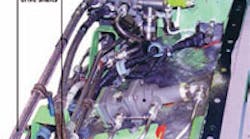Photo shows example of how flexible shafts transmit rotational power between components — many times the only solution for such cramped quarters.
|
Flexible rotary shafts from S. S. White, however, are designed to transmit bidirectional rotation and torque. Rotational power is transmitted through layers of wires made of stainless steel or other high-strength material and helically wound in opposite directions. Reaction forces from the layers helically wound in opposite directions tend to cancel each other out, so the layers don’t unravel regardless of which direction they turn. The shafts also transmit high torque within a small OD — in fact, the shafts are often located within the hydraulic tubing routed to each actuator.
Here’s how it works. As an actuator extends, the ball nut follows the motion. The ball nut, therefore, rotates the ball screw according to its pitch. The flexible shaft transmits the rotational motion of the ball screw to the ball screw of the next assembly in succession. This ensures that all ball screws, ball nuts, and actuator pistons all move in concert.
Flexible benefits
Construction of a flexible shaft begins with a core, around which high-strength wire is helically wound either clockwise or counter-clockwise. A second layer of wire is then helically wound in the opposite direction over the first layer. This alternating clockwise and counter-clockwise continues until the desired diameter is reached. Lubrication, an outer casing, and end fittings are then added to complete the assembly. To reduce maintenance, and eliminate potential contamination in aerospace applications, S.S. White also offers Flexcellent, a permanently lubricated system.
Flexible rotary shafts offer many benefits over alternative technologies, such as gearing and universal joints. Flexible shafts allow generous design freedom because component alignment (both angular and parallel offset) is almost a non-issue. They have a higher power density and are quieter and more efficient than gearing or universal joints. They are also easier and less costly to install, and can be designed in at the later stages of a project.
For more information on flexible rotary shafts from S.S. White Technologies, visit www.sswhite.net, call (732) 474-1700, or e-mail [email protected]. Click here for a brief tutorial on flexible shafts.


